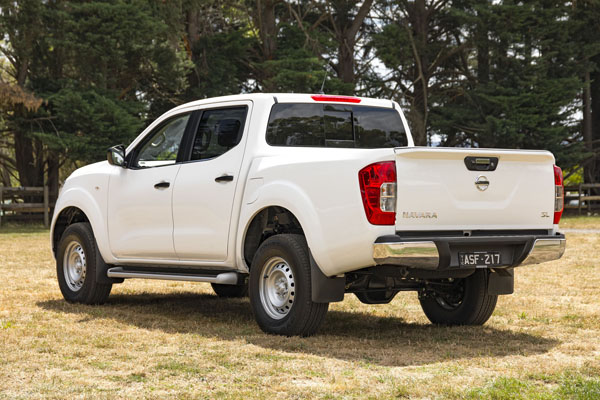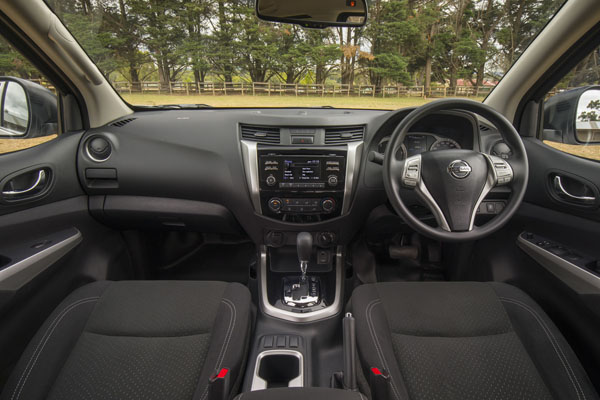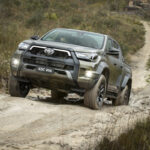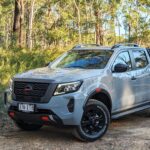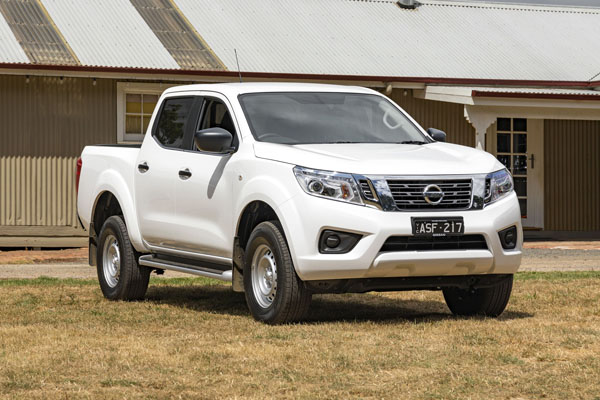
This placid pick-up truck is a far cry from previous iterations of the popular workhorse, which Nissan would be the first to admit to being rather agricultural in character. Not that the new chum is a shrinking violet.
Performance upgrades give the 2018 Nissan Navara more pulling power on and off road, while offering an easier and more enjoyable to drive, both of which were illustrated on a launch drive in Melbourne and surroundings.
Initiated by Nissan Australia, and tested extensively in, and exclusively for conditions Down Under by Nissan ute experts from around the world, upgrades apply to Dual Cab SL, ST and ST-X variants in the Australasian market.
Particular attention was paid to ride and handling with a new dual-rate rear-spring system incorporating an integrated lower and higher spring rate. This comes up with a comfortable ride unladen or with a light payload and allows heavier loads to be hauled without compromise in ride and handling, the last especially when towing.
Also, steering ratio on Dual Cab SL, ST and ST-X was trimmed from 21.5:1 to 19.0:1, so the steering wheel is turned less to get the angle, or degree of turn, from the wheels, while lock-to-lock steering wheel turns have been cut from 4.1 to 3.4, both making the Navara more manoeuvrable.
The 2018 Nissan Navara has also upped the ante in safety with technology updates including a 360 degree Around View monitor, standard on ST-X grades, second row IsoFix child seat mounting points, on all Dual Cabs, and rear-view cameras are now available on all Pickup variants, while satellite navigation has been added to King Cab ST.
And from June production, all SL, ST and ST-X models will feature a digital speedometer included in the instrument cluster, and tie-down hook points have been either increased in number or re-positioned to help secure loads.
Three cabin styles are on offer. These include the Single Cab, King Cab and the most popular model, the Dual Cab. There are 27 Pickup and eight Cab Chassis options and 10 4×2 and 25 4×4 variants.
Power is supplied by one of two engines, the most popular being the 2.3-litre intercooled twin-turbo diesel with 140 kW of power at 3750 rpm and 450 Nm of torque between 1500 and 2500 revs. There’s a choice of a six-speed manual or a seven-speed automatic transmission, the latter with manual mode.
The Navara boasts class-leading fuel consumption of 6.5 litres per 100 kilometres on the combined urban / highway cycle.
While prices generally remain unchanged, eight of the variants carry increases between $200 and $500, reflecting additional gear that is now standard. Pricing for Single Cab starts at $25,990, King Cabs come from $28,490 and the Dual Cab from $33,490.
For $1500 extra Nissan offers a leather accented seat option on King Cab ST-X seven-speed auto and all Dual Cab ST-X grades. A tilt-and-slide electric sunroof package is also available for $1000 on the Dual Cab ST-X 4×4. Available in eight exterior colours, the 2018 Navara is on sale now.
Announcing the new Navara Nissan Australia the media was addressed by Ashwani Gupta, vice-president of Renault’s Light Commercial Vehicle Division since 2014, where he oversees Renault / Nissan worldwide LCV business.
Mr Gupta said, while not a volume market, Australia was a trendsetter in sports utility vehicle performance development throughout the world, so local testing in Victoria had been a feature of the new Navara.
It was also stacked up against its main rivals, the Toyota Hilux, Ford Ranger and Holden Colorado.
With this in mind, Nissan Australia wheeled out its upgraded Navara for a media launch in Melbourne and the Yarra Valley. First cab off the rank, so to speak, for this writer was an ST Dual Cab with no load in the tub.
Rolling on Toyo A25 Open Country tyres, the 4×4 served up little road noise inside. The cabin calm was enhanced by a mere hum from the engine, even when pushed.
Steering was light with enough feedback to keep the vehicle on an even keel, even on testing winding, narrow country roads. On a mix of city and country driving, fuel consumption of 8 litres per 100 kilometres.
Next up was an ST-X with a 650 kg load tied down in the back. There was a definite push from behind downhill on he bitumen, as you would expect with a load on board.
On an undulating stretch of gravel, the Navara 4×4 stood its ground, producing a stable ride with sure-footed grip at every turn.
However, the climax came with an SL Dual Cab with trailer hitched, toting a cement mixer, plus gravel and sand cruising the Hume Freeway at the legal speed limit, with not a twitch from behind.
Hills presented no problem to the set-up, either climbing or descending, after all the Navara is rated to tow 3500 kg braked. All in all, the 2018 Navara showed much improvement in performance on the vehicle it replaces, no bad thing in such a robust market.
AT A GLANCE
MODEL RANGE
Single Cab
DX 4×4 6MT Cab Chassis $31,990
RX 4×2 6MT Cab Chassis $25,990
RX 4×4 6MT Cab Chassis $32,990
RX 4×4 7AT Cab Chassis $35,490
King Cab
RX 4×2 6MT Cab Chassis $28,490
RX 4×4 6MT Cab Chassis $35,490
RX 4×4 6MT Pickup $37,290
ST 4×4 6MT Pickup $43,990
ST 4×4 7AT Pickup $46,490
ST-X 4×4 6MT Pickup $49,990
ST-X 4×4 7AT Pickup $52,490
Dual Cab
RX 4×2 6MT Pickup $33,490
RX 4×2 7AT Pickup $35,990
ST 4×2 6MT Pickup $40,190
ST 4×2 7AT Pickup $42,690
ST-X 4×2 6MT Pickup $44,990
ST-X 4×2 7AT Pickup $47,490
RX 4×4 6MT Cab Chassis $38,490
RX 4×4 7AT Cab Chassis $40,990
RX 4×4 7AT Pickup $42,990
SL 4×4 6MT Pickup $43,990
SL 4×4 7AT Pickup $46,490
ST 4×4 6MT Pickup $47,190
ST 4×4 7AT Pickup $49,690
ST-X 4×4 6MT Pickup $51,990
ST-X 4×4 7AT Pickup $54,490
Leather Seat Option $1500 – Leather accented door trim, leather accented seats, 8-way power driver’s seat with lumbar support, heated front seats
Sunroof Option $1000 – Tilt and slide electric sunroof
Premium paint $550
Note: These prices do not include government or dealer delivery charges. Contact your local Nissan dealer for drive-away prices.




